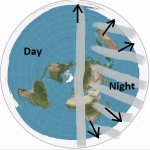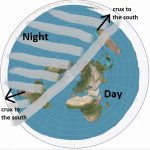This is what I do not understand about a flat earth.
The way we see it going from night to day, and from day to night.
How does it happen that way on a flat earth.
If it is a flat earth then there would have to be a dividing point between light and dark for it is not always dark and it is not always light.
That means on a flat earth it would be dark in our area and then we would see the light coming in the distance but it is still dark in our area, and then the light would pass through our area and we would see the dark going away in the distance until it is gone.
The same way it is light in our area going to dark.
But we do not observe it that way and the light does not chase the darkness that way.
The light and the dark do not change like an electric [light] switch turning on/off. The light is not one inch away from the dark. It changes gradually over a much greater distance.
(However, it is at times faster in the southern latitudes than in the northern latitudes - during the southern summer - because the sun is moving faster.)
What we actually see:
~ Before we can see the sun itself in a direct line-of-sight, we see 'light' appearing from the point on the horizon where we will eventually see the sun 'rise' from.
~ This 'light' is not "equally distributed" across the entire horizon; rather, it is "contoured around" the sun-rise point on the horizon. It is brightest there and grows more dim outward in all directions in the sky.
~ This 'light' spreads out in all directions as time passes - "chasing" the dark across the sky. By the time we see the sun itself, most of the sky has been "lightened* - [generally] from-east-to-west - with the most-dark area [still] in the western sky.
~ As the sun 'rises' from the horizon, the entire sky will be "lightened" more-and-more until the entire sky is 'light' and there is no 'dark'.
~ When the sun 'sets', the reverse happens.
~ The 'dark' then "follows" the 'light' as it disappears beyond the horizon.
~ The 'light' is not "equally distributed" across the entire horizon; rather, it is "contoured around" the sun-set point on the horizon.
~ The 'light' eventually disappears, leaving the 'dark' to fill the sky.
This matches the FE model. It
does not match the BE model.
But it makes sense on a round earth for when the sun comes up, boom, it is light all across the earth we can see, and when the sun goes down, boom, it is dark all across the earth that we can see.
Nowhere on earth does it change from complete-total-dark to complete-total-light in an instant. Nor does it change from complete-total-light to complete-total-dark in an instant.
It always takes
some amount of time.
In the north latitudes, it can take
hours for the full sun-rise or sun-set to occur.
In the south latitudes, it can occur in only
minutes.
And, the fact that it is different in the north latitudes than it is in the south latitudes is evidence for the FE model.
On a flat earth it does not make sense how we observe it going from dark to light, and light to dark.
It makes perfect sense - because - it perfectly matches what we actually see.
It only makes sense on a round earth.
It only makes sense in the FE Model because it only matches the FE Model in terms of what we actually see.




